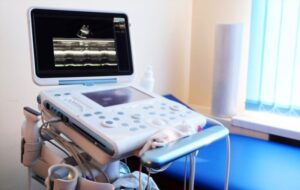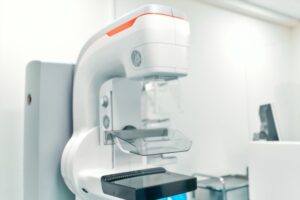Breast cancer is an example of a disease where an early diagnosis may save lives. It’s important to get a regular breast cancer screening, which involves examining your breasts for lumps or changes in the tissue. While some people prefer doing their own screening at home, others prefer to have a doctor or nurse do a clinical evaluation during an appointment.
Mammograms detect breast cancer in women. Ultrasound and mammography can help a doctor assess changes in breast tissue in some circumstances. But many are confused about which imaging process to go for and what is the difference between ultrasound and mammogram. In this blog, learn about breast cancer imaging diagnostics and screenings so that you can make an informed decision regarding mammograms vs. ultrasounds.
Introduction to Ultrasound

Ultrasound imaging employs sound waves to provide an image of the inside workings of the human body. A technician takes pictures of the breast tissue while doing a breast ultrasound. They place a wand called a transducer throughout the imaging process across the breasts. The transducer creates a picture by sending sound waves back to the transducer after bouncing off the breast tissue.
When screening for breast cancer, a breast ultrasound isn’t the most reliable method. A doctor may perform a sonogram of the breasts to rule out breast cancer. In certain cases, a doctor may utilize a breast ultrasound to advise them during a breast biopsy.
Pregnant women and those who must avoid x-rays and other radiation-based imaging may utilize a breast ultrasound since it does not use radiation.
Introduction to Mammogram

A mammogram is an x-ray image of the breasts used to detect abnormalities. Early identification and screening for breast cancer rely heavily on this test. The ability to identify breast cancer using mammography may occur up to three years before the tumor is visible.
Breast cancer risk and a woman’s age have a role in the advantages of a mammogram. Annual mammograms may be beneficial for women with an average risk of breast cancer starting at the age of forty. Only a woman and her doctor can decide how often she should have mammograms when it comes down to it. Women who have a greater risk of developing breast cancer may need more regular mammograms than women with an average or low risk of developing breast cancer.
The breast lies on a plate at chest level during mammography. Two plates slide on top of each other to flatten down the breast and keep it motionless while an x-ray machine takes a picture. The x-ray technician will take four photographs total, two of each breast, throughout the procedure.
Screening mammography can have either normal or abnormal results, depending on the radiologist’s findings. In certain cases, abnormal results on screening mammography aren’t indicative of breast cancer. After an abnormal finding, the technician generally performs diagnostic mammography to obtain further pictures.
Breast Ultrasound vs Breast Mammogram
Does a breast ultrasound outperform a mammogram? Following abnormal screening mammography, a doctor request both tests, although there are some significant distinctions between them. The following are some of the differences between the two.
-
This is the imaging technique:
A diagnostic test’s modality refers to the imaging modality employed. For imaging, ultrasound employs sound waves, whereas x-rays utilize radiation from electromagnetic waves.
-
The quality of the images:
X-rays and ultrasounds provide distinct images. Ultrasound pictures, in general, are unable to catch microcalcifications. The tiniest of calcium deposits in the breast may frequently be the first indications of malignancy. Mammography, on the other hand, will reveal them.
-
Motives for using image technology:
When screening mammography is abnormal, a doctor requests an ultrasound or a diagnostic mammogram to investigate the issue further. Using a breast ultrasound isn’t only for follow-up purposes. As part of a breast biopsy, doctors may extract a small sample of the breast tissue and do a cancer screening. Using ultrasound imaging, they can make sure that they are injecting directly into the right part of the breast.
-
Breast ultrasonography is not presently advised for breast cancer screening since it may miss early signals of a tumor:
An ultrasound may be a better option for certain people than mammography. Women expecting should avoid having x-rays taken unless it is absolutely necessary. A prenatal breast ultrasound may replace mammography. A breast ultrasound may be a preferable alternative for younger women, especially those in their early twenties.
Mammogram vs Ultrasound for Breast Cancer Screening: Which Is Best for You?
What’s best for one individual may not be best for another when it comes to medical care and therapy. If you’re unsure about whether diagnostic mammography or breast ultrasound is right for you, talk to your doctor. Here are a few things to think about before making a choice with your doctor.
Your age: For women under 30, your doctor can suggest an ultrasound instead of mammography to check the health of their breasts. Breast cancer screening for younger women is generally discouraged unless there is an established family history of the illness or a woman has other factors that increase her chance of developing the disease.
Your weight: The quality of the images gathered might be affected by factors such as your weight and the size of your breasts. In women with thick breast tissue, mammography may be unable to identify malignancies. So your doctor may order an ultrasound along with a mammogram. Some women may not acquire reliable pictures from a breast ultrasound because of their large breasts or weight problems.
Purpose of the imaging: To assess whether or not you need cyst draining, your doctor may use breast ultrasound instead of other imaging methods.
Risk factors: If you cannot get x-rays, an ultrasound may be the best alternative for your situation.

